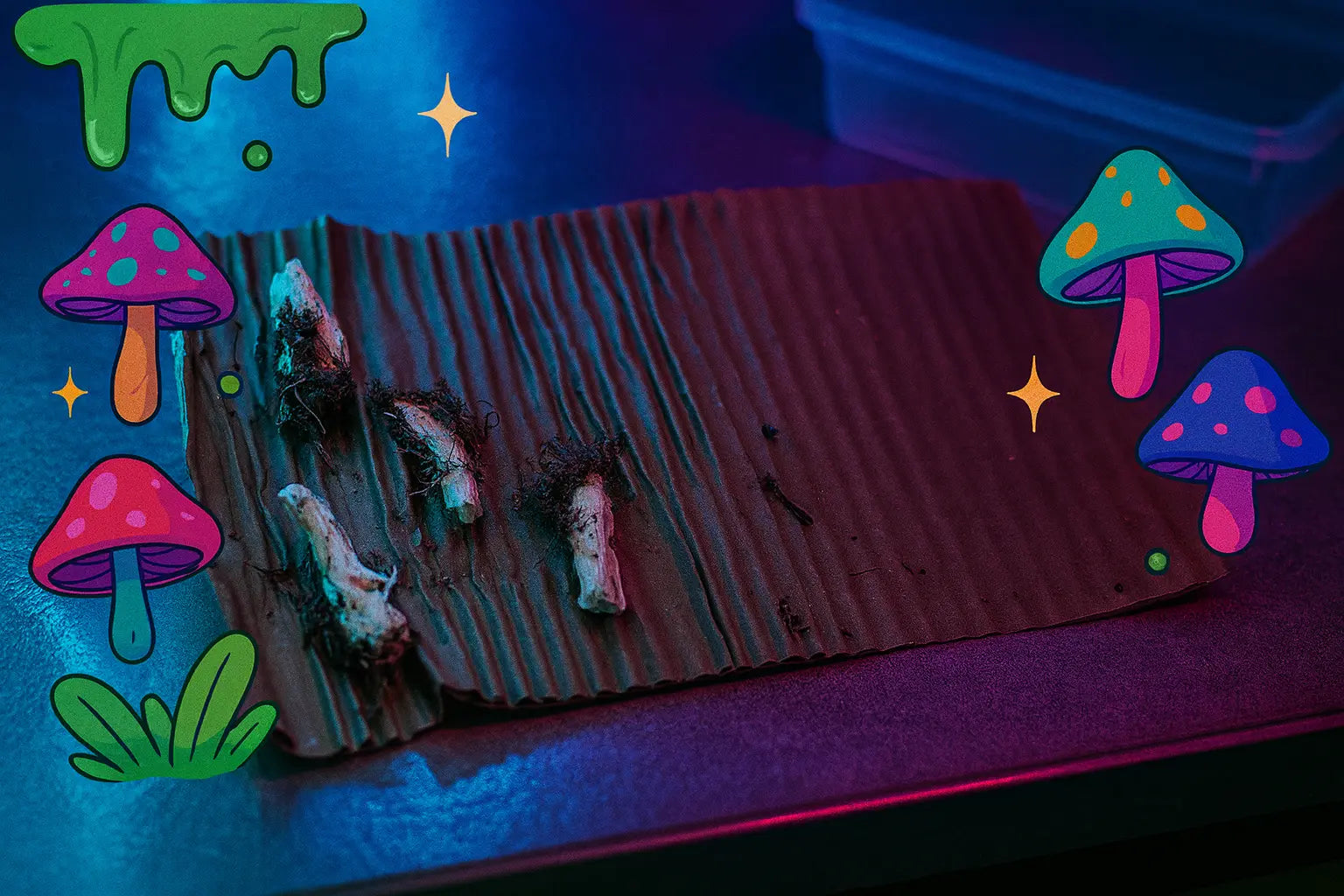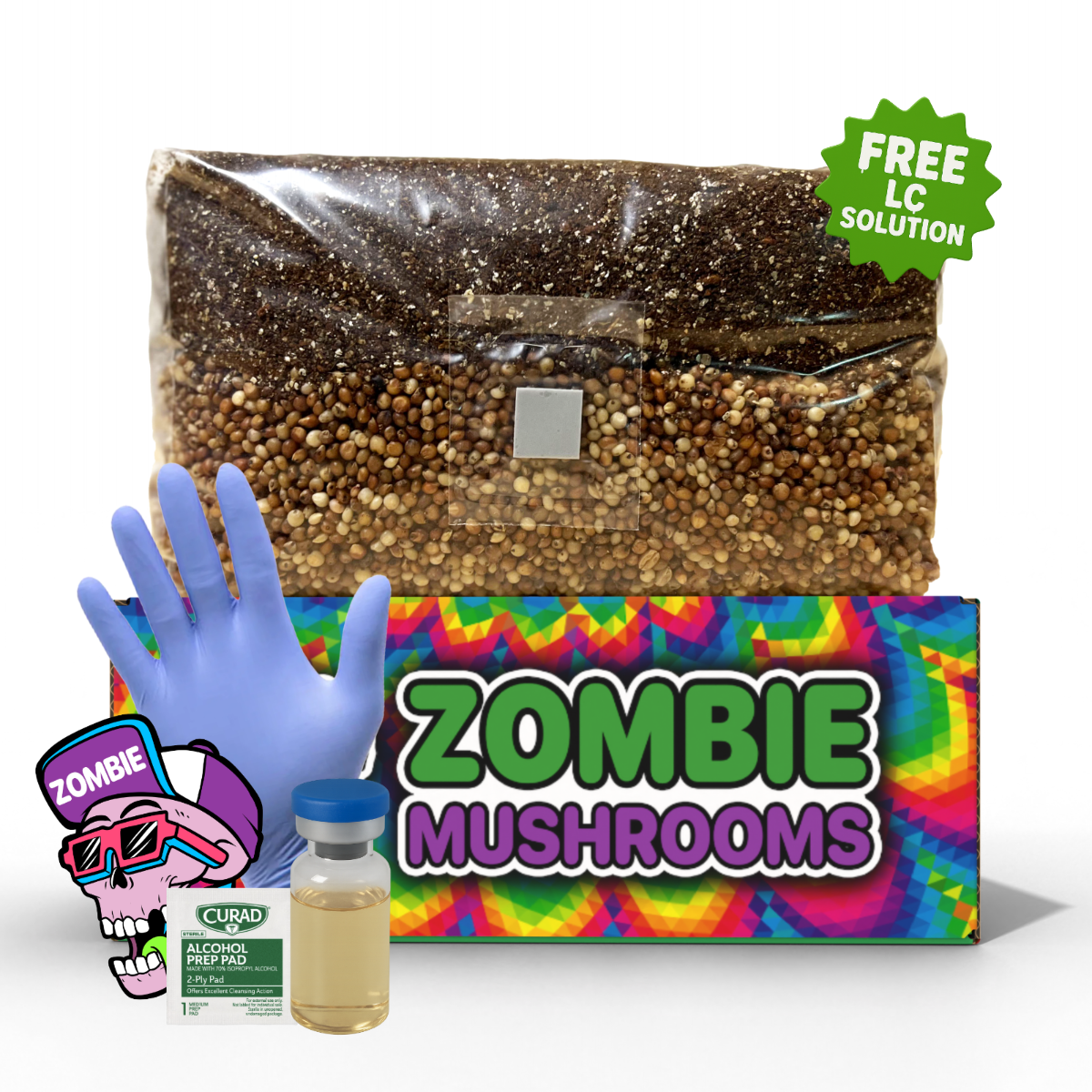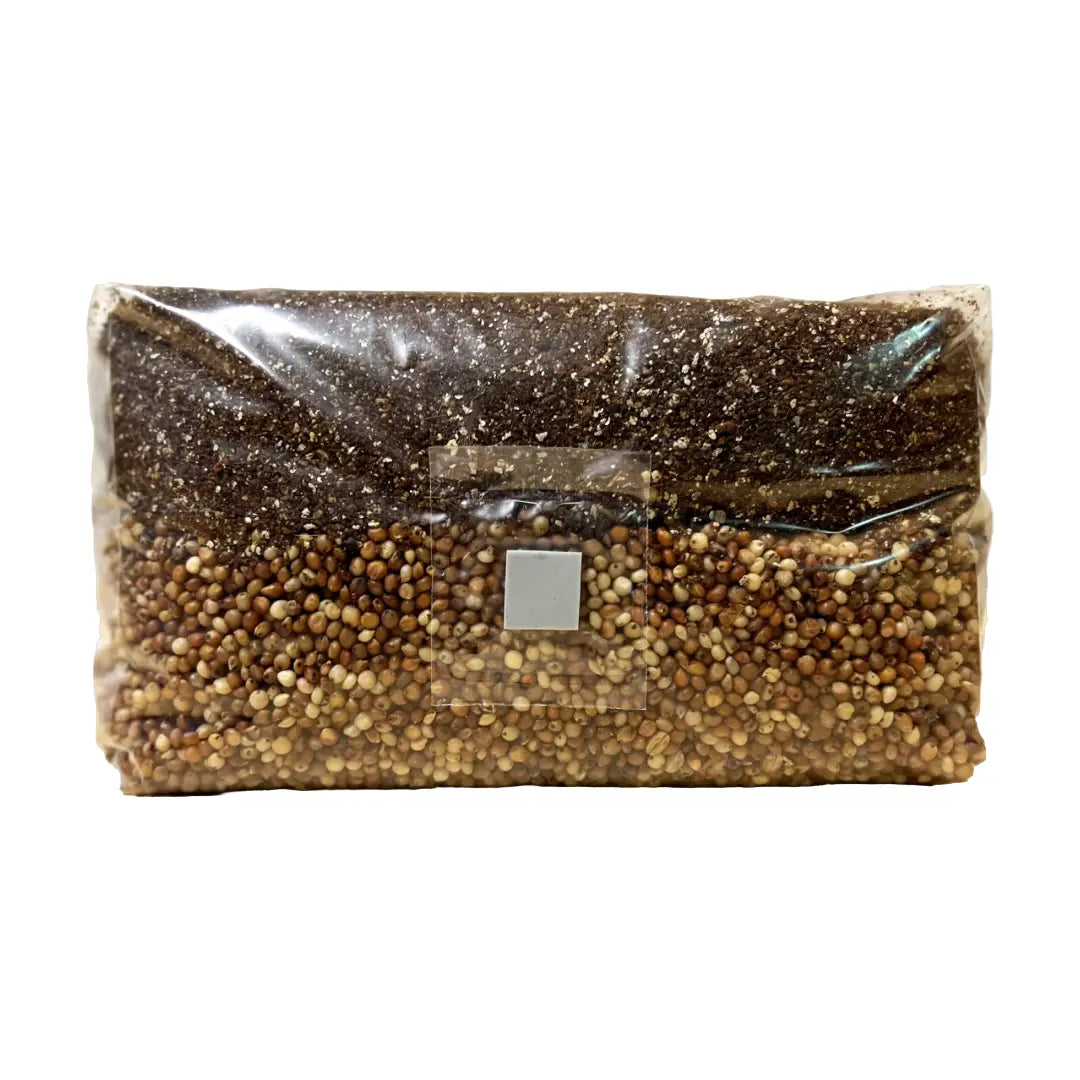⬇️ Prefer to listen instead? ⬇️

- 🍄 Oyster mushrooms are ideal for cardboard because they rapidly colonize cellulose-rich materials.
- 🔬 Studies show cardboard provides fungi with both moisture retention and airflow, key for mycelium health.
- ♻️ Cardboard mushroom cultivation offers a low-cost, zero-waste, and beginner-friendly way to grow food.
- 📉 Limitations include lower nutrient availability and possible contamination without proper pasteurization.
- 🌱 Cardboard spawn can scale up mushroom production for garden beds, logs, and permaculture systems.

Why Use Cardboard to Grow Mushrooms?
Growing mushrooms on cardboard is an accessible and eco-friendly method, especially for beginners. Cardboard provides a cellulose-rich structure, mimicking the decaying wood mushrooms naturally thrive on. For those seeking a streamlined approach, using Mushroom Grow Bags can simplify the process. These bags offer a contained environment, reducing contamination risks and enhancing mycelium colonization, making them an excellent choice for cultivating mushrooms at home.
The main good thing about cardboard is that it is a simple, natural material to start with. Other things used for growing, like hardwood pellets or sterilized grain, need special steps or expensive sterilization tools. But you probably have cardboard at home already from shopping and packages.
From an environmental view, growing on cardboard fits well with permaculture ideas. Instead of throwing old boxes in the trash or sending them to be recycled, you can use them again to grow food. And also, cardboard has no animal parts. This makes it good for vegan or organic growing, if you get the right kind.
If you want to grow in a simple, sustainable way, learning to grow mushrooms on cardboard is a useful, plain way to start with fungi.

Is Cardboard Safe to Grow Mushrooms On?
Many beginners wonder about the safety of growing mushrooms on cardboard. When done correctly, it's a safe and sustainable practice. Ensure you use plain, uncoated cardboard to avoid contaminants. Additionally, incorporating Mushroom Grow Bags can further ensure a clean growing environment, as they provide a sterile space for mycelium development.
Choosing the Right Cardboard
Start with plain, brown corrugated cardboard. This is the type of shipping box you get from Amazon, grocery stores, and other shops. It is mostly cellulose. And it has very few harmful things if it has no printing or coating.
Do not use these kinds of cardboard:
- Colored or shiny cardboard
- Surfaces with a lot of dye or wax
- Boxes with many logos or brand designs
- Cardboard that has touched oils, old food, or chemicals
Today, many inks are soy-based and safe. But big printing jobs still often use oil-based inks or coatings. To be safe, choose clean cardboard with no coating.
Adhesives and Contaminants
Cardboard boxes use glue to hold layers together. Some glues can stop mushroom growth or even hurt fungi a little. To lessen this, peel off inside layers that have too much glue. Or pick cardboard types with very little glue you can see.
Importance of Pasteurization
You must pasteurize your cardboard before adding mushroom spawn. Even if the material looks clean, it might have bacteria, mold, or insect larvae. The usual home method is to soak cardboard in hot water, 150-160°F (65-70°C), for at least an hour. This kills most things that could compete. It also keeps good microbes that do not hurt mushroom growth.
All in all, with clean, plain cardboard and simple cleaning, this way of growing mushrooms at home stays very safe.

What Kind of Mushrooms Can Be Grown on Cardboard?
Oyster mushrooms are the best-known kind for growing on cardboard. But other types can also grow well using this material, sometimes with a few changes or added nutrients.
1. Oyster Mushrooms (Pleurotus spp.)
Oyster mushrooms break down things quickly and spread fast. They can break down straw, coffee grounds, and cardboard. They adjust easily and grow fast, so they are great for new growers. Some oyster types work especially well with cardboard:
- Blue Oyster (P. ostreatus var. columbinus)
- Pink Oyster (P. djamor)
- Golden Oyster (P. citrinopileatus)
Oyster mushrooms quickly beat out other unwanted things and break down lignin and cellulose. This is why growing them on cardboard is the most dependable way.
2. Lion’s Mane (Hericium erinaceus)
Lion’s Mane has a mild taste and can help nerves grow. It can grow on cardboard. But it often grows better on materials with more food in them. Adding hardwood chips or sawdust to the cardboard makes it much more likely to work.
3. Shiitake (Lentinula edodes)
Shiitake mushrooms usually like hardwood sawdust or logs. Some people say they have grown shiitakes on cardboard with sawdust or bran layers. But shiitakes take longer to grow and make mushrooms. So, they are not the best for new growers using cardboard. Still, they are an option for experienced growers ready to add things and wait.
Avoid Compost-Preferred Species
Button mushrooms (Agaricus bisporus) and portobellos like compost with lots of food, not cellulose. They do not grow well on cardboard. So, they are not good choices for this method.

The Science Behind Cardboard and Mycelium
To know how mycelium and cardboard work together, you need to look at how fungi live. Mycelium is the stringy part of mushrooms. It breaks down dead plants and animals to get food. In nature, mycelium is the main thing that breaks down dead wood.
Cardboard is like rotting plant wood. It has lots of cellulose and hemicellulose fibers. This gives wood-loving fungi, like oysters, food. And also:
- 🧽 Holds water: The fibers in cardboard hold water well. This keeps the air wet, which mushrooms need.
- 🌬️ Air flow and shape: The wavy parts of cardboard make air pockets. This lessens the chance of too little air, which causes rot or mold.
- 🌿 Breaks down naturally: Cardboard breaks down slowly. It gives out food over time, so it does not give the mycelium too much at once.
Paul Stamets points out that oysters eat cellulose. This is part of what they do in nature in forests (Stamets, 2000). This is why they grow so well on cardboard.

How to Make Mushroom Spawn on Cardboard?
To create mushroom spawn on cardboard, begin by soaking the cardboard to soften it. Then, layer it with mycelium or pieces of mushrooms. Allow this setup to colonize in a warm, dark environment. This method is particularly effective for species like oyster mushrooms, which readily colonize cardboard substrates.
Materials Needed
- Plain corrugated cardboard
- Hot water (for pasteurization)
- Mushroom spawn (liquid or grain spawn)
- Clear plastic box, tub, or a grow bag with tiny holes
- Knife or scissors
Step-by-Step Instructions
-
Pasteurize
Tear cardboard into small pieces. Put it in water heated to 150-160°F (65-70°C) for 1 hour. This kills most mold and bacteria. -
Cool and Drain
After pasteurizing, let the cardboard drain for 30 minutes. It needs to be wet, but not dripping. -
Add Spawn
In a clean box, make layers of wet cardboard and mushroom spawn. Grain spawn works best, but liquid spawn also works. Start with a spawn layer at the bottom. This helps mycelium grow everywhere. -
Keep Warm
Close the box or cover it loosely so air can get in and out. Put it in a clean, dark, and warm place, 65–75°F. You do not need light at this time. -
Watch it Grow
You should see white mycelium strings in 3 to 7 days. Usually, all the cardboard will be covered in about 2 weeks. This time depends on the temperature and how healthy your spawn is. -
Ready to Use
Cardboard that is fully covered with mycelium can now grow mushrooms in the same box. Or you can use it to add mycelium to other things like straw, wood chips, or compost.
How to Make Cardboard Spawn
Cardboard is good because it can make more mycelium simply and without much mess. Once mycelium grows on it, the cardboard acts like a starter for bigger projects.
Creating Cardboard Spawn
- Use cardboard that already has mycelium growing on it, from an earlier batch or spore culture.
- Tear it up and layer it into new boxes with fresh, pasteurized cardboard.
- Use tape or cover it loosely so air can move.
- Keep it warm again, 65–75°F.
With this method, you can "stretch" a little bit of store-bought or grown spawn. One piece can become ten or more. You can use this homemade cardboard spawn to:
- Add mycelium to straw for more mushrooms
- Start mushroom beds outside
- Put fungi into logs or garden mulch
It is a great way to grow more naturally, especially for people who garden or live on a homestead.

Step-by-Step: How to Grow Mushrooms on Cardboard
Let’s put all this together into a simple, clear plan for growing oyster mushrooms:
What You Need
- Plain corrugated cardboard
- Hot water and a box for pasteurization
- Oyster mushroom spawn (grain spawn is best)
- A clean plastic tub or grow bag
- Spray bottle (to keep things wet)
Instructions
-
Get Ready
- Tear cardboard into pieces about the size of your hand.
- Pasteurize it in 160°F water for 1 hour. Then drain it well.
-
Add Spawn
- Make layers of wet cardboard and spawn in a plastic box with a lid.
- Make holes or leave it loose so air can get in and out.
-
Keep Warm
- Keep the box in a warm, dim place. A closet is good.
- You can see the mycelium growing through clear boxes.
-
Grow Mushrooms
- Move the box into indirect light.
- Spray with water 1 to 2 times a day to keep it wet.
- Cut holes for air to move.
-
Pick Mushrooms
- Look for caps that are curled but starting to get flat.
- Use sharp scissors to cut them cleanly. Leave the base mycelium.

Pros of Growing Mushrooms on Cardboard
- ✅ Almost free: Uses trash from your home and extra stuff.
- ✅ Needs simple tools: You do not need pressure cookers or special air filters.
- ✅ Good for kids and learning: A fun science project for homes and schools.
- ✅ Good for the environment: Cuts down on waste and makes healthy food.

Cons and Limitations
- ❌ Small harvests: Cardboard does not have much food. Expect small amounts of mushrooms or use it to grow on richer materials.
- ❌ Only one harvest usually: Most cardboard batches cannot make mushrooms many times.
- ❌ Risk of mold: Bad draining or not keeping things clean can bring mold.
You can lessen these problems by adding more food to your cardboard. Or move your colonized cardboard to outdoor projects.

Common Issues and Troubleshooting
- 🦠 Mold shows up fast: This is likely from too much water, wrong pasteurization, or bad spawn.
- 🌡️ Mycelium not growing: Make sure your growing spot is warm enough. Also check that the cardboard is evenly wet.
- 🌬️ Dries out too soon: Cover loosely to keep air moving. And spray water often.
Fixing these problems early helps you have a good first growing experience.
Tips for Enhancing Cardboard-Based Kits
Do you want more mushrooms? Here are some ways to make your kits better:
- 💡 Mix in used coffee grounds: These are already pasteurized and have lots of nitrogen.
- 🌾 Add straw or bran: This gives food for a longer time for more harvests.
- 🌱 Stack things up: This makes better use of space and air in small gardens.
- 🧪 Buy good grain spawn: Like the kind from Zombie Mushrooms, for faster growth.
Even small changes make it more likely you will grow mushrooms well at home.
When to Harvest and What to Expect
Knowing when to pick oyster mushrooms is important:
- Pick when caps are not fully flat or turned up.
- Gills should be seen but have no spores.
- Mushrooms should look full and healthy.
Your first group of mushrooms usually comes 10 to 14 days after you start growing them. If you pick them cleanly and add water again, you might get 2 to 3 harvests from the same cardboard.

Scaling Up from Cardboard to Larger Projects
Growing on cardboard is not just for new growers. It is a step to farming in a lasting way. Once you know how to grow on cardboard:
- Use cardboard with mycelium as spawn for straw bales or wood chip beds.
- Put layers into raised beds to fit permaculture ideas.
- Drill into logs to grow mushrooms at home for a long time.
- Make stacked small greenhouses from old crates and plastic.
Each step helps you grow more and learn more. You go from a hobby grower to someone who grows in a way that helps the earth.
FAQ Section
Q1: What is mushroom spawn?
A1: Mushroom spawn is a substrate that already has mycelium growing on it. It's used to inoculate other substrates, promoting mushroom growth.
Q2: Can I use any cardboard for growing mushrooms?
A2: It's best to use plain, uncoated cardboard to avoid contaminants. Recycled cardboard from shipping boxes is often ideal.
Q3: How long does it take for mushrooms to grow on cardboard?
A3: After inoculation, it typically takes 2-3 weeks for the mycelium to colonize the cardboard fully. Fruiting can begin shortly after that, depending on environmental conditions.
Q4: Do I need special equipment to grow mushrooms on cardboard?
A4: Basic supplies include cardboard, mushroom spawn, and a warm, dark environment. For enhanced results, Mushroom Grow Bags can provide a controlled setting for optimal growth.
Final Thoughts: Is Cardboard Cultivation Right for You?
Growing mushrooms on cardboard shows you do not need costly tools or a science degree to start growing fungi. With few things, some patience, and the right spawn—like from Zombie Mushrooms—you can turn simple old packaging into fresh, edible mushrooms. You can use them for your kitchen, garden, or classroom. This method is safe, lasting, and satisfying. It is a good way to start growing mushrooms at home. It works whether you grow oyster mushrooms on cardboard to make your spawn last, to teach science, or to feed your family.
Citations
Beyer, D. (2005). Mushroom Cultivation and Marketing. Penn State Extension.
Stamets, P. (2000). Growing Gourmet and Medicinal Mushrooms (3rd ed.). Ten Speed Press.
Royse, D. J., Baars, J., & Tan, Q. (2017). Current Overview of Mushroom Production in the World. In D. Zied & A. Pardo-Giménez (Eds.), Edible and Medicinal Mushrooms.



